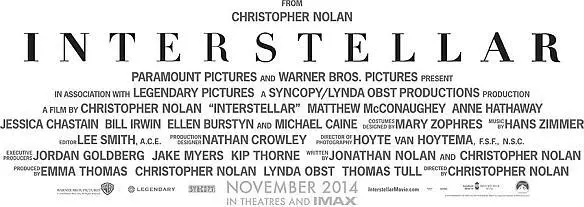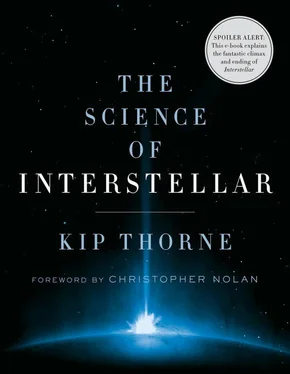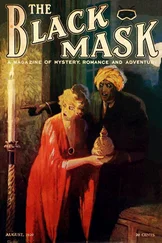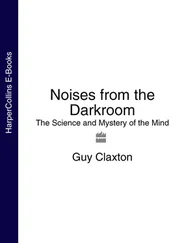Gravitation Theory and Gravitational Collapse (with B. Kent Harrison, Masami Wakano, and John Archibald Wheeler)

Copyright © 2014 Itzy
Text © Kip Thorne
Foreword copyright © 2014 by Christopher Nolan
Film © 2014 Warner Bros. Entertainment Inc.
INTERSTELLAR and all related characters and elements are trademarks of and © Warner Bros. Entertainment Inc.
WB SHIELD: TM & © Warner Bros. Entertainment Inc.
The following images from the book are included with permission from Warner Bros.: Figures 1.2, 3.3, 3.4, 3.6, 5.6, 8.1, 8.5, 8.6, 9.7, 9.9, 9.10, 9.11, 11.1, 14.9, 15.2, 15.4, 15.5, 17.5, 17.9, 18.1, 19.2, 19.3, 20.1, 20.2, 24.5, 25.1, 25.7, 25.8, 25.9, 27.8, 28.3, 29.8, 29.14, 30.1, and 31.1. Images © 2014 Warner Bros. Entertainment Inc.
All rights reserved
First Edition
For information about permission to reproduce selections from this book, write to Permissions, W. W. Norton & Company, Inc., 500 Fifth Avenue, New York, NY 10110
For information about special discounts for bulk purchases, please contact W. W. Norton Special Sales at specialsales@wwnorton.com or 800-233-4830
Book design by Chris Welch
Production managers: Julia Druskin and Joe Lops
ISBN 978-0-393-35137-8
ISBN 978-0-393-35138-5 (e-book)
W. W. Norton & Company, Inc.
500 Fifth Avenue, New York, N.Y. 10110
www.wwnorton.com
W. W. Norton & Company Ltd.
Castle House, 75/76 Wells Street, London W1T 3QT

See Chapter 25.
Google “gravitational waves from the big bang” or “CMB polarization” to learn about this amazing March 2014 discovery. I give some details at the end of Chapter 16.
A light-year is the distance light travels in one year: about a hundred trillion kilometers.
In more technical language, its mass is a million times that of the Sun’s or more, which means its gravitational pull, when you are at some fixed distance away from it, is the same as a million Suns’. In this book I use “mass” and “weight” to mean the same thing.
In these realms, for example, the energy of light has huge quantum fluctuations. They are so huge that they warp space and time enormously and randomly. The fluctuating warpage is beyond the scope of Einstein’s relativistic laws, and the warpage’s influence on the light is beyond the scope of the light’s quantum laws.
The phrase “fiery marriage” was coined by my mentor John Wheeler, who was superb at naming things. John also coined the words “black hole” and “wormhole” and the phrase “a black hole has no hair”; Chapters 14 and 5. He once described to me lying in a warm bath for hours on end, letting his mind soar in a search for just the right word or phrase.
Chapters 5, 6, and 8.
See Some Technical Notes at the end of this book.
But see the first section of Chapter 24.
Unchanging after well-understood corrections for a bit of slowdown due to interaction with electrons in interplanetary space—so-called “plasma corrections.”
In 1907, Einstein realized that if he were to fall, off the roof of his house for example, then as he fell he would feel no gravity. He called this the “happiest thought of my life,” because it got him started on his quest to understand gravity, the quest that led to his concepts of warped time and space and the laws that govern the warping.
If it is possible to go backward in time, you can only do so by traveling outward in space and then returning to your starting point before you left. You cannot go backward in time at some fixed location, while watching others go forward in time there. More on this in Chapter 30.
The literal French translation of “a black hole has no hair” is so obscene that French publishers resisted it vigorously, to no avail.
For some quantitative details, see Some Technical Notes , at the end of this book.
A more reasonable value might be 200 million times the Sun’s mass, but I want to keep the numbers simple and there’s a lot of slop in this one, so I chose 100 million.
See Figure 17.2 and the discussion of it in Chapter 17.
In other words, its spin is the maximum minus 0.00000000000001 of the maximum.
When TARS falls in, the Endurance is not far, far away, but rather is on the critical orbit, quite near the horizon, whirling around the hole nearly as fast as TARS; so Amelia Brand, in the Endurance , does not see TARS swept around at high speed. For more on this, see Chapter 27.
The probability of finding IMBH’s at the needed locations and times is small, but in the spirit of science fiction, since it is within the bounds of physical law, we can utilize them.
See Figures 6.4 and 6.5.
The friction arises through a complex process where moving gas winds the field up, strengthening it and thereby converting energy of motion into magnetic energy; and then the magnetic field, pointing in opposite directions in neighboring regions of space, reconnects and in the process converts magnetic energy into heat. That’s the nature of friction: a conversion of motion into heat.
I changed the size of the hole to that of Gargantua and the size of the star to that of a red giant, and changed the time markers in Figure 9.5 accordingly.
The angular momentum is the object’s circumferential speed multiplied by its distance from Gargantua; and this angular momentum is important because it is constant along the object’s orbit, even if the orbit is complicated.
Chloroplasts and photosynthesis also occur in algae, and in cyanobacteria in the ocean, both of which I treat as plant life in my simplified description. (In some sense, cyanobacteria are a form of chloroplast.)
For some quantitative details and explanations of the huge uncertainties in the geophysical estimates, see Some Technical Notes at the end of the book.
The kinetic energy is Mv 2/2, where M is the helium atom’s mass and v is its speed. Equate this to the energy released, 0.0064 Mc 2, where c is the speed of light. (I used Einstein’s famous result that when you convert mass into energy, the energy you get out is the mass multiplied by the square of the speed of light.) The result from equating these two formulas is v 2 = 2 × 0.0064 c 2, which means v is close to c/10 .
Energy is weird in relativistic physics; the energy one measures depends on how fast one moves and in what direction.
Recall that Oliver James, chief scientist at Double Negative, wrote the computer code that underlies Interstellar ’s visualizations of wormholes and black holes; see Chapters 1 and 8.
Читать дальше














